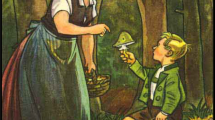Abstract
This paper is a demonstration of an application of Semiotic Textology to a limited case study. The main aspects of Semiotic Textology, the theory elaborated by Petöfi, are presented; secondly the linguistic aspects of the interpretation of lines 133–134 of the Theognis of Megara’s poem, analysed in the framework of said theory, are presented. All the relevant syntactic, semantic, pragmatic information involved in text processing have been considered. Through fixed steps, it is shown that text processing is not exclusively a grammatical activity, because within a theoretical interpretation an Interpreter needs a number of contextual hypotheses, in order to understand the author’s ontology.
Similar content being viewed by others
References
Austin J. (1962) How to do things with words. Harvard University Press, Cambridge, MA
de Beaugrande R., Dressler W. U. (1981) Introduction to text linguistics. Longman, London
Dodds E. (1951) The Greeks and the irrational. University of California Press, Berkeley, Los Angeles
Giuffrè M. (2011) Demosthenes and the Greek Oral Culture in the framework of Semiotic Textology. An application of János Sándor Petöfi’s theory to Classical Greek Literature. In: Giuffrè M. (eds) Sprachtheorie und Germanistische Linguistik. Studies in Semiotic Textology in Honour of János S. Petöfi. Nodus Publikationen, Münster, pp 65–98
Heydrich W. (1978) Argumentrollenindicatoren. In: Biasci C., Fritsche J. (eds) Texttheorie-Textrepräsentation. Theoretische Grundlagen der kanonischensinnsemantischen Repräsentation von Texten. Buske, Hamburg, pp 97–114
Heydrich, W. (1980). A System of argument-role indicators. In H. J. Eikmeyer, W. Heydrich, J. S. Petöfi (Eds.), Some aspects of formal foundation in text semantics (pp. 53–72). Bielefeld: Projekt Formale Textsemantik (= Materialien des Universitätsschwerpunktes Mathematisierung der Einzelwissenschaften, Heft XXVI).
Jaynes J. (1976) The origin of consciousness in the breakdown of the bicameral mind. Houghton Mifflin, Boston
La Matina M. (1994) Il testo antico. L’Epos, Palermo
La Matina M. (2001) Il problema del significante. Carocci, Roma
McLuhan M. (1962) The gutenberg galaxy. University of Toronto Press, Toronto
Montague R. (1974) Formal philosophy: Selected papers of Richard Montague. Yale University Press, New Haven
Morris, C. W. (1938). Foundations of the Theory of Signs. In V. V., A. A. (Eds.), Towards an international encyclopaedia of unified science. Chicago: Chicago University Press.
Ogden C. K., Richards I. A. (1923) The meaning of meaning (8th Ed). Harcourt, Brace & World, Inc, New York
Petöfi J. S. (1971) Transformationsgrammatiken und eine ko-textuelle Texttheorie. Grundfragen und Konzeptionen. Athenäum, Frankfurt
Petöfi J. S. (1973) Towards an empirically motivated grammatical theory of verbal texts. In: Petöfi J. S., Rieser H. (eds) Studies in text grammar. Reidel, Dordrecht, pp 205–275
Petöfi J. S. (1978) A formal semiotic text theory as an integrated theory of natural languages. In: Dressler W. (eds) Current trends in text linguistics. de Gruyter, Berlin, pp 35–46
Petöfi, J. S. (1980). Representation Languages and their Function in Text Interpretation. In H. J. Eikmeyer, W. Heydrich, & J. S. Petöfi (Eds.), Some aspects of formal foundation in text semantics (pp. 73–131). Bielefeld: Projekt Formale Textsemantik (= Materialien des Universitätsschwerpunktes Mathematisierung der Einzelwissenschaften, Heft XXVI).
Petöfi J. S. (1982) Meaning, text interpretation, pragmatic-semantic text classes. Poetics 11: 435–491
Petöfi J. S. (1983) Das Forschungsobjekt X und Aspekte der X-logie. In: Faust M., Harweg R., Lehfeldt W., Wienold G. (eds) Allgemeine Sprachwissenschaft. Gunter Narr, Tübingen, pp 403–415
Petöfi J. S. (1984) Constitution and meaning: a semiotic text-theoretical approach. In: Conte M. E., Petöfi J. S. (eds) Text and discourse connectedness. Proceedings of the Conference on Connexity and Coherence. John Benjamins, Amsterdam, Philadelphia, pp 507–542
Petöfi, J. S. (1988). La struttura della comunicazione in Atti 20, 17-38. In G. Galli (a cura), Interpretazione e strutture. Le strutture del discorso di Paolo a Mileto (pp. 123–176). Torino: Marietti.
Petöfi, J. S. (1989). Readers and reader models. In Versus. Quaderni di studi semiotici, 52/53 (gennaio-maggio) (pp. 43–52).
Petöfi J. S. (1995) Die semiotische Textologie und die pragmatischen Aspekte der Kommunikation. In: Kertész A. (eds) Sprache als Kognition. Sprache als Interaktion. Studien zum Grammatik-Pragmatik-Verhältnis. Peter Lang, Frankfurt am Main-Berlin, pp 59–99
Petöfi, J. S. (1996). Dal testo alla comunicazione umana multimediale. In J. S. Petöfi & L. Vitacolonna (Eds.), Sistemi segnici e loro uso nella comunicazione umana 3. La Testologia semiotica e la comunicazione umana multimediale (pp. 51–65). Macerata: Quaderni di Ricerca e Didattica dell’ Università n. XVII, Dipartimento di Filosofia e Scienze umane.
Alcuni aspetti della Testologia Semiotica. Modello segnico—Tipi di interpretazione. In J. S. Petöfi (Ed.), Sistemi segnici e loro uso nella comunicazione umana 5. Comunicazione visiva: parole e immagini in comunicati statici (pp. 21–30).: Quaderni di ricerca e didattica XX, Dipartimento di filosofia e Scienze Umane.
Petöfi J. S. (2004) Scrittura e interpretazione. Introduzione alla Testologia Semiotica dei testi verbali. Carocci, Roma
Petöfi J. S., Olivi T. (1989) Understanding literary texts. A semiotic textological approach. In: Meutsch D., Viehoff R. (eds) Comprehension of literary discourse. Walter de Gruyter, Berlin, NY, pp 190–225
Snell B. (1963) Die Entdeckung des Geistes. Studien zur Entstehung des europäischen Denkens bei den Griechen. Claassen Verlag, Hamburg
Toselli S., Olivi T. (1996) Verso la testologia semiotica dei testi multimediali. In: Petöfi J. S., Vitacolonna L. (eds) Sistemi segnici e loro uso nella comunicazione umana 3. La Testologia semiotica e la comunicazione umana multimediale. Quaderni di Ricerca e Didattica dell’Università à di Macerata n. XVII, Dipartimento di Filosofia e Scienze umane, Macerata, pp 154–161
Young D. (1971) Theognis. Post Ernestum Diehl iterum edidit Douglas Young. Bibliotheca Scriptorum Graecorum et Romanorum Teubneriana, Leipzig
Author information
Authors and Affiliations
Corresponding author
Rights and permissions
About this article
Cite this article
Giuffrè, M. Theognis of Megara and the Divine Creating Power in the Framework of Semiotic Textology: An Application of János Sándor Petöfi’s Theory to Archaic Greek Literature. J of Log Lang and Inf 21, 325–346 (2012). https://doi.org/10.1007/s10849-011-9155-8
Published:
Issue Date:
DOI: https://doi.org/10.1007/s10849-011-9155-8




